-
![img]()
Home Organising 101: Maintaining Order with Storage Solutions
Zakwan Shah
January 01, 2025
4 min
The art of home organisation involves two ultimate goals: maximising space and minimising clutter.
The end result is a peaceful, welcoming home where everything is where it should be. Not a single item out of place.
Having an organised home can reduce stress, improve your mental health and boost your mood.
Let's kick off the New Year by re-organising your home!
Here are 8 storage ideas for a calm and relaxing home this 2025.Make Preparations

Home organising, while not a full-blown renovation, still involves some major changes to your household.
This requires a little bit of planning.
You should ideally declutter and sort the items that you plan to organise.
Recycle or donate them if that’s best for everyone.
You should also measure spaces where you plan on installing storage solutions.
This ensures you return home from the hardware store with the right-sized items.
And if you’re replacing or overhauling furniture, make sure you dismantle them properly.Keep Things Where They Are Used

Keep laundry paraphernalia near the washing machine.
Store shoes near the front door or in your closet.
Hide linens and sheets under your bed.
This not only ensures easy access, but also allows you to cater the space to the storage solution.
For example, it’s much more practical to keep boxes under your bed for linens, and floating shelves near the washing machine for detergents.Install Floating Shelves

Floating shelves are exactly as their name suggests.
They are shelves that are mounted on walls and are usually just a simple piece of polished wood held up with metal brackets.
Depending on the strength and durability of the material, you can put anything from books to laundry detergents.
They don’t cost much, yet they maximise your storage options and are relatively easy to install with the proper tools.
If you’re renting and don’t want to leave pockmarks on the walls, opt for adhesive shelves.
However, there may be a weight limit for these.Put Everything in Boxes
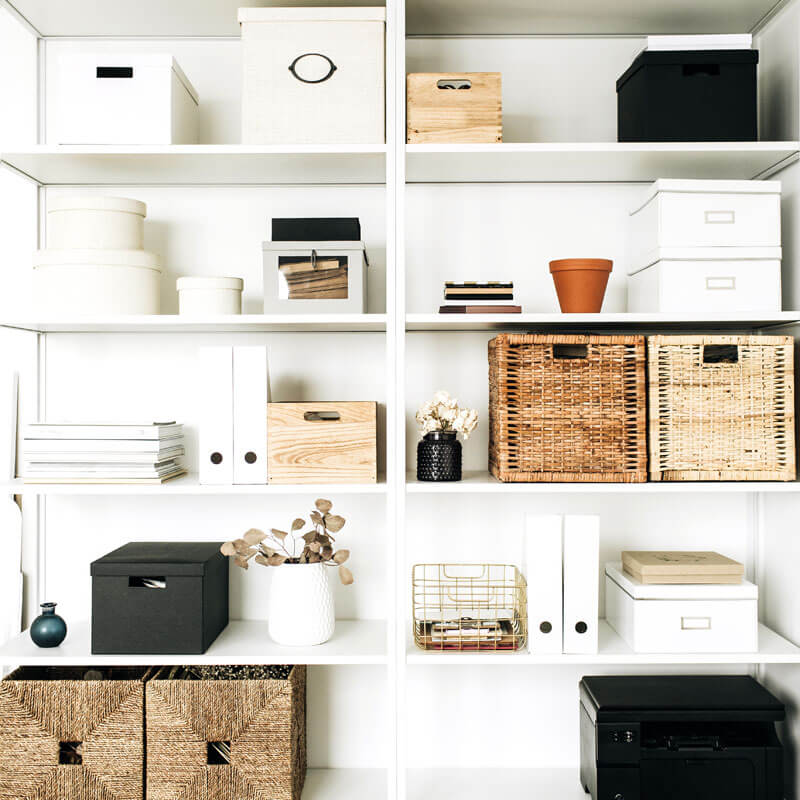
Boxes are a great way to store small or foldable items that you want to keep out of sight.
Stackable drawers are another good option.
Boxes are all well and good until you start stacking them. Then they become a pain to handle.
With drawers, you can easily access the items stored within without unstacking them.
You might want to only get those in neutral and uniform colours.
If you use too many shades, they will end up drawing attention and throwing off the peaceful vibe.Label Everything
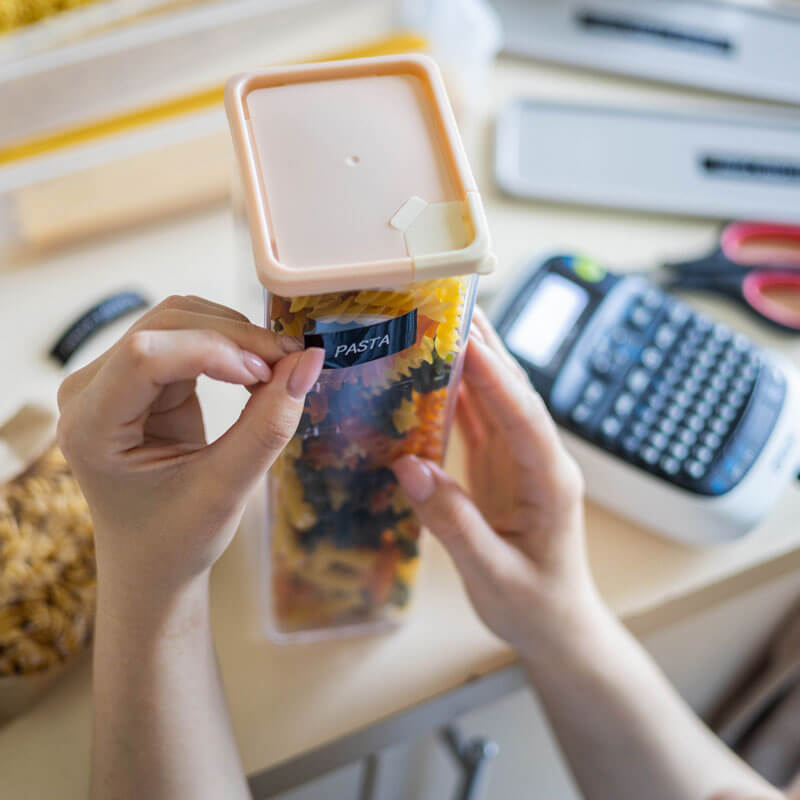
Once you get your boxes, be sure to put some labels on them.
Commercial label makers can be a bit pricey, so if you want to DIY that there are some options.
Of course, make sure to keep those labels out of sight.
Make sure to keep them simple, too.
If you want to take it a step further, get cloth boxes with little pockets on the side. You can hide a list of contents in them for inventory purposes.
This is especially useful for hardware, food items, stationery, and consumables.Utilise Corners
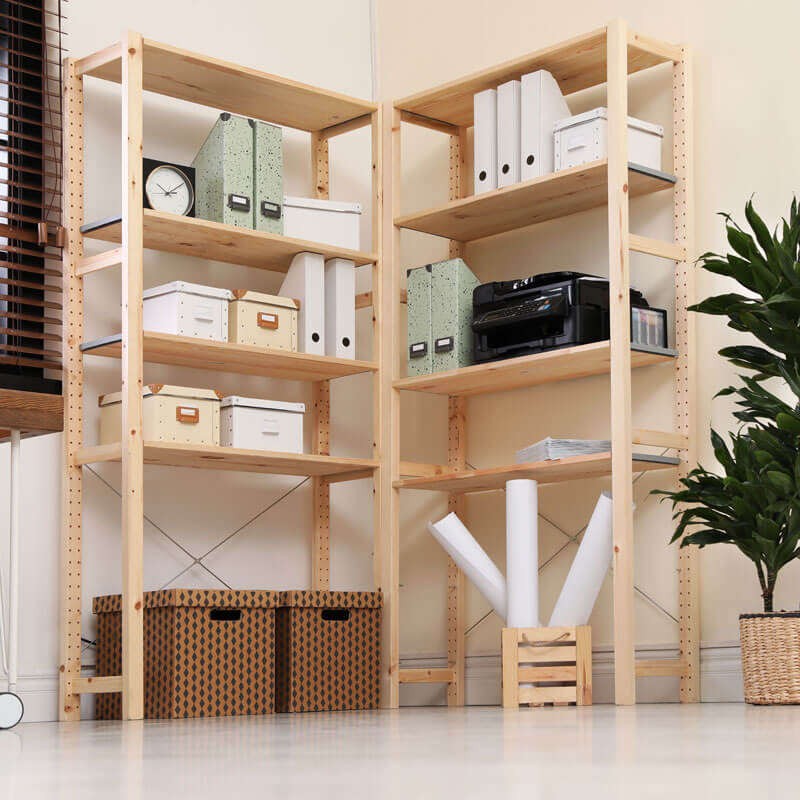
Corners are such a neglected space in the house and hold enormous potential for storage.
However, for places like the living room or bedroom, it's best to use them for display purposes instead of closed storage. Otherwise, they will look out of place.
But use your discretion.
Some corner cabinets have exposed shelves at the top and a storage cupboard at the bottom.
These are so versatile and can be used for virtually anything.
If your child likes playing in the living room, the bottom cupboard can be where they keep their toys after they’re done.
This can also be a great opportunity to teach your kids about organising their own belongings.Hide Your Things
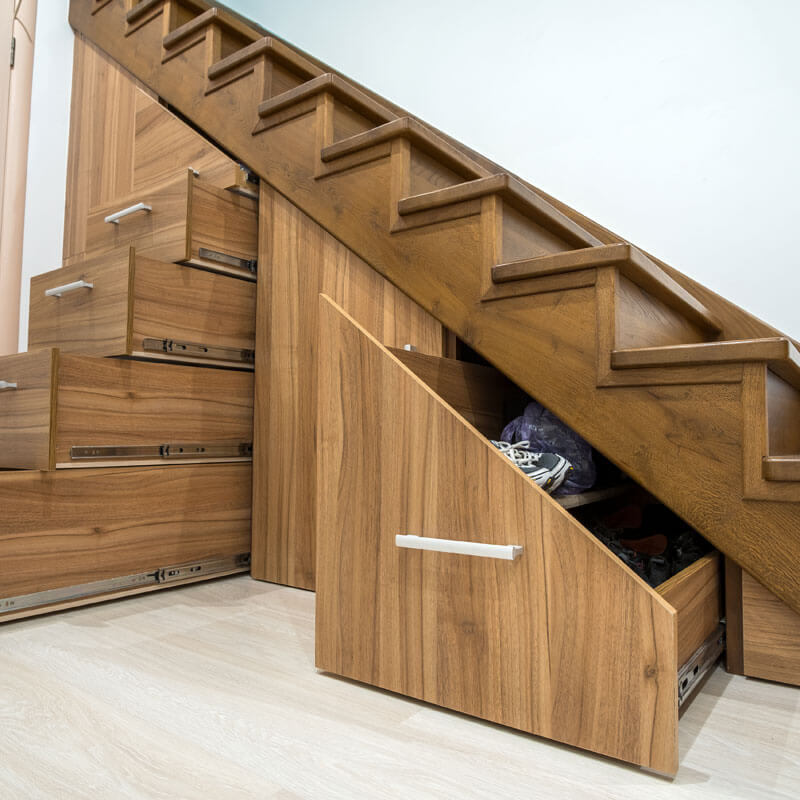
There are plenty of home furniture with built-in storage solutions.
Beds with drawers installed on the sides. Sofas that pop up to reveal hidden compartments within. Coffee tables with a sliding top. And chairs that double as storage cabinets.
If you’re a DIY master woodworker, you can practically do all this yourself.
But let’s assume most of us are just normal people with no carpentry expertise.
If that’s the case, then it’s time to do some research.
Make sure you have a budget first before going window shopping, that way you won’t overspend.Keep Everything Uniform

Even if your house is vibrant, it’s generally a good idea to keep storage solutions uniform in colour, shape, and size.
If you can, buy from the same brand.
Storage takes care of the space problem, but uniformity takes care of the peaceful aspect.
You don’t want your drawers, shelves, and cabinets to be an eyesore.
White also gives it that minimalistic look that won’t make your house look too cluttered.Organising Your Home Is Now Easier Than Ever
Home organising can tame the chaos in your living spaces and give you peace of mind.
While it does require some pre-planning, it’s well worth the effort. Especially when you have guests coming over.
Having the little hidden spots where you can temporarily store stray items is a good shortcut for easy cleaning. Moreover, you know where everything is.
The next time you need something, you won’t tear through the house like an angry tornado looking for that one thing.
If you want to know more about how to be an organised super-mum, here are some ways you can do that.
So, give these storage ideas a try, they may just restore the order and harmony in your home.
Motherhood wishes you and yours a Happy 2025 with love!
Disclaimer: The information provided in this article is for informational purposes only and should not be considered as medical advice from Motherhood. For any health-related concerns, it is advisable to consult with a qualified healthcare professional or medical practitioner.
For more insightful stories and fun recipes, stay tuned to Motherhood Story!
-
![img]()
17 Easy Confinement Fish Recipes
Natasha
December 31, 2021
14 min
I know some postpartum mummies might run out of fish confinement recipes ideas at some point. Fret not! We have here a list of healthy confinement fish recipes which you easily can prepare in the comforts of your home.
These recipes are suitable to be eaten by both postpartum mummies and your whole family! Without further ado, let's explore these 17 easy confinement fish recipes together, shall we?
Postpartum mummies need to know that there are certain fish that are healthy for your confinement and some which should be avoided. Check out a list of fishes which you can eat during your postpartum period here.Fishes You May Eat During Your Postpartum Period

- Salmon
- Mackerel
- White pomfret fish
- Red snapper
- Snakehead Fish
- Anchovies
- Cod
- Mullet fish
- Seabass
Discover which type of fishes are postpartum-friendly, should be eaten in moderation and need to be avoided during your postpartum period here!
Aside from that, following a healthy recipe can also help in ensuring you maintain a healthy diet. This is really significant for your postpartum body and healing process. Below are some of the significance of maintaining a healthy confinement diet for postpartum mummies.Why Postpartum Mummies Should Maintain a Healthy Diet

- Quicken your healing process.
- Heal your wounds after giving birth.
- Recover your internal systems.
- Prevent postpartum 'wind' from entering your body and causing body aches.
- So the food would not cause any itches in mummies' maternity wounds or cause the wound to heal slowly.
- Boost your breast milk supply.
17 Easy Confinement Fish Recipes
Steamed Mackerel Fish with Black Pepper

This confinement recipe contains many nutritious food for your postpartum recovery, mackerel fish and black pepper! Mackerel is great source of omega-3 fatty acids as it can reduce some symptoms associated with depression. Additionally, black pepper can also help mummies heal their postpartum bodies.
- 3-4 pieces mackerel fish (flesh) (cleaned)
- 1 shallot (sliced)
- 3 cloves garlic (sliced)
- 3 cm ginger
- a little black pepper
- 1 spoon oyster sauce
- a little lemon zest
- salt (as per taste)
Arrange the fish properly and toss the shallot, garlic and ginger onto the fish.
Marinate the fish with some oyster sauce, salt and black pepper.
Steam the fish around 10-15 minutes or until it is fully cooked. (You do not have to add on any water as the fish will produce some juices.)
Steamed Snapper with Ginger

Do try this confinement recipe! It contains ginger that can help to promote your blood circulation and boost gastrointestinal function. Not only that, ginger can also help to enhance your breast milk.
- 1 snapper fish (cleaned and cut)
- 6 cloves garlic (thinly sliced)
- 2 inches ginger (thinly sliced)
- 2-3 key lime (squeeze the juice)
- 1 spoon fish sauce
- a little water
- salt (as per taste)
- spring onion (sliced)
- 3-4 bird's eye chillies (sliced)
Prepare the streamer pot and boil the water.
Coat the fish with salt and put it into the pot.
Sprinkle some garlic and ginger on top. Steam the fish until it is half cooked.
Then, add the fish sauce, water, bird's eye chillies and key lime juice. Steam it until it is fully cooked.
When it is done, sprinkle some spring onion and let it simmer for a moment.
Serve this dish with a bowl of hot rice.
Red Snapper Fish Soup

Postpartum mums must eat a lot of fish! This is because it is a great source of protein and other essential nutrients. It is also easy to digest and cook.
- 1 red snapper (cleaned and cut)
- 4 shallots (sliced)
- 2 cloves garlic (sliced)
- a little ginger (sliced)
- cinnamon stick
- star anise
- cardamom
- black pepper (as per taste)
- salt (as per taste)
- 1 sup bunjut ikan
- a little spring onion (cut)
Boil the water with the sup bunjut ikan, shallots, garlic, cinnamon stick, star anise and cardamom.
Once the water reaches to a boil, place the fish into the pot.
Sprinkle on some black pepper and salt to your liking.
Add some spring onions and fried onions on top. Turn off the stove and serve this dish with a bowl of hot rice.
Snakehead Fish Soup with Black Pepper

Snakehead fish is a great source of all amino acids and fatty acids that are significant in wound recovery. If you eat this fish, your wound should eventually heal within around 2 months. This is a popular fish among confinement dishes.
- 1 snakehead fish (cleaned and cut)
- 1 inch ginger (thinly sliced)
- 3 shallots (sliced)
- 2 cloves garlic (sliced)
- piece tamarind slice
- 1 spoon black pepper
- salt (as per taste)
- water
Boil all the ingredients except for the fish.
Let the water boil and put the fish in the pot. Reduce the flame.
Let it simmer until the fish and other ingredients are fully cooked.
Sprinkle some salt and serve this soup with a bowl of hot rice.
Mackerel in Sour Gravy (Ikan Tenggiri Masak Asam)

Mummies must try this yummy recipe as it can help supply a lot of protein and promote your digestive system.
- 500 ml water
- 3 pieces mackerel fish
- 1/2 cup Javanese acid water
- 1/2 tbsp black pepper
- salt (as per taste)
- 30 g ginger (sliced)
- 3 shallots (sliced)
Boil all the ingredients in a pot with a small flame.
Cook until the gravy is quite thick and the fish is cooked.
Mix all the ingredients well before serving.
Ikan Bawal Asam Jawa
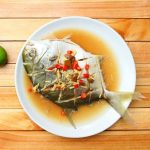
Silver pomfret is a great source of nutrients that help to improve your blood circulation and digestive health. This fish can also reduce swelling and promote your breast milk production.
- 1 pomfret fish (cleaned and cut)
- 2 ginger (sliced)
- 1 fresh turmeric (sliced)
- 1 tbsp Javanese acid water
- black pepper (as per taste)
- salt (as per taste)
Coat the fish with all the ingredients.
Steam the fish until it is cooked.
Serve with a bowl of hot rice.
Singgang Fish (Singgang Ikan)

Singgang dish is a popular Malay confinement dish as it contains many nutritious ingredients that can help with your healing process. Do try this recipe!
- 3 pieces mackerel fish (big) (clean and cut)
- 3 cloves garlic
- 7 bird's eye chilli
- 2 cm galangal (thinly sliced)
- 2 cm fresh turmeric (thinly sliced)
- 3 pieces tamarind slices
- 4 cups water
- salt (as per taste)
Put all the ingredients in a pot.
Cook the ingredients until the fish is cooked. Let the gravy simmer and turn off the stove.
Serve with a hot bowl of rice.
Grilled Mackerel with Yummy Spiced Coconut Paste (Pais Ikan Tenggiri)

This recipe can supply protein to your body. This dish is great as it boosts your energy, radiates your skin and warms your body.
- 1 piece mackerel fish (clean and cut in the middle)
- 5-6 kaffir lime leaves (julienned cut)
- 2 cups desiccated coconut
- 2 medium-size onions
- 10 stalks bird’s eye chillies
- 2 tbsp chilli paste
- 4 cloves garlic
- 1 inch turmeric root (thinly sliced)
- 3 stalks lemongrass (thinly sliced)
- 1-2 eggs
- 1 tbsp tamarind water
- sugar (as per taste)
- salt (as per taste)
- 3 tbsp coconut milk (optional)
- a few banana leaves (seared to ensure banana leaves don’t tear upon wrapping)
- some oil
Blend the desiccated coconut, onions, bird’s eye chillies, onions, chili paste, garlic, turmeric root, lemongrass, eggs, tamarind water and coconut milk until a smooth paste is formed.
Pour the blended paste into a small bowl. Using a spoon, stuff the fish with the spice paste. If there’s excess, spread it evenly around the fish. This will give more flavour to the fish and enhance the smokiness of the flesh.
Using a brush, coat the banana leaves with some oil and place the stuffed fish in the middle. Sprinkle the kaffir lime leaves.
Wrap the fish, burrito-like.
Grill the fish on a wide pan and medium high flame for 10-15 minutes, or until the fish is fully cooked.
Serve this dish with a bowl of hot rice and sambal.
Grilled Fish with Ginger

Ginger is a great traditional herb that has many health benefits. It can help to improve your digestive health, heart health, warm up your body, relieve the 'wind' from your body and promote blood circulation.
Ingredient A
- 2 pieces mackerel fish (cleaned and cut)
- 1 calamansi (extract the juice)
- turmeric powder (according to your liking)
- salt (as per taste)
- oil
Ingredient B (Slice)
- 30 g young ginger
- 1 large onion
- 4 shallots
- 3 cloves garlic
Coat the fish with Ingredient A.
Marinate the fish for around 30 minutes.
Grill the fish until it is fully cooked. Then, put it aside.
Heat the pan with a little bit of oil.
Sauté Ingredient B until you can smell the aroma.
Turn off the stove and sprinkle the ingredients on top of the fish.
Fish Curry without Coconut Milk

Fish curry can help to boost breast milk supply for new mums.
- 300 g fish ( Marinate it with little salt and turmeric powder)
- 1 onion
- 2 tomato
- 2 slits green chillies
- 2 tbsp chilli powder
- 3 tbsp coriander powder
- 1/2 tbsp turmeric powder
- 2 tbsp ginger garlic paste
- tamarind water
- A few curry leaves
- 1 tbsp cooking oil
- 1 tbsp mustard seeds
- 1/4 tbsp fenugreek seeds
- salt (as per taste)
Heat the oil in a pan. Add mustard seed and allow it to crackle .
Add fenugreek seeds and fry for few seconds. Make sure to not to burn it.
Add onion, green chillies, curry leaves and fry them until translucent.
Add ginger garlic paste and fry until cooked.
Add turmeric, chilli powder and coriander powder and fry the ingredients .
Add tomato and sprinkle some salt, fry it until soft.
Add tamarind juice and water. Then, allow it to boil.
Add water as per your preferred consistency.
Once it starts boiling, add the fish and cook for 15 – 20 minutes, or until the gravy thickens and the oil floats on top. Your cooking time depends on the size of the fish.
Garnish with curry leaves or coriander leaves.
Serve with a bowl of hot rice.
Fish Congee

Do try out this recipe! Fish congee is very nourishing and give warmth support your postpartum bodies. Eat this dish with ikan bilis masak asam.
- 3 litre water
- 1/2 cup medium-grain rice
- 1 piece the flesh or red snapper (cut into small chunks)
- 3 inches fresh ginger root (thinly sliced)
- 1 spring onion (sliced)
- 2 tbsp chicken seasoning powder
- 1/2 tbsp black pepper
- 3 tbsp fresh parsley (chopped)
- 1/2 tbsp salt
Combine water and rice in a large pot over high heat. Bring to a boil; simmer for 5 minutes. Reduce heat to medium-low and simmer until rice is tender, about 30 minutes.
Combine fish, ginger, spring onion, chicken seasoning powder, and pepper in a bowl. Let marinate for 15 minutes.
Stir fish mixture into the pot. Simmer gently until the rice is very soft and the fish is falling apart, about 20 minutes. Season with parsley and salt.
Stir Fry Fish with Onion

You may try this fish recipe but remember to limit the consumption oil in your cooking.
- 1 piece the flesh of red snapper (cleaned and cut)
- 1 clove garlic (sliced)
- 1 cm young ginger (sliced)
- a little spring onion (sliced)
- salt (as per taste)
- black pepper (as per taste)
- a little cooking oil
Marinate the fish with salt and black pepper.
Fry the fish with a little bit of oil and put it aside.
Sauté the garlic and ginger.
Then, place the fried fish back on the pan.
Sprinkle some spring onion.
Serve with a bowl of hot rice.
Crispy Anchovies Assam Style (Ikan Bilis Masak Asam)
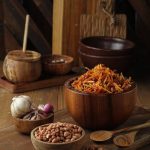
Anchovies can help to relieve indigestion and oedema. This fish can also boost your breast milk supply and bone health. It can also prevent anaemia and osteoporosis.
- 1 bowl anchovies
- 1/2 bowl potatoes (sliced)
- 1 large onion (sliced)
- 4 cloves garlic (sliced)
- 1 cup Javanese acid water
- salt (as per taste)
- black pepper (as per taste)
Fry the anchovies and potatoes. Then, put them aside.
Sauté the garlic and onion with a little bit of oil until it is cooked.
Add back the fried anchovies and potatoes on the pan.
Add some Javanese acid water and mix the ingredients well.
Sauté the dish until it is cooked.
Season with salt and black pepper.
Salmon Aglio Olio Pasta

New mummies should eat more salmon! It is rich in DHA which helps boost your breast milk and is great for your newborn's nervous system, It can also promote your immune system and delay aging.
- 400 g salmon
- 200 g spaghetti
- capsicums (green, yellow and red colour) (diced)
- garlic
- carrot
- 1 tbsp dried chilli
- 1 tbsp butter
- black pepper (as per taste)
- chili powder (as per taste)
- salt (as per taste)
Cook spaghetti in a pot of boiling water for about 2 minutes.
Marinade the salmon slices with salt, black pepper, and chili powder. Grill the salmon until it is cooked. Then, cut the salmon into cubes.
Sauté the garlic until fragrant.
Add the carrots, capsicums and dried chillies into the pan. Mix them well and sauté the ingredients until it partially cooked.
Add the spaghetti into the pot and mix all the ingredients. Season it with salt, black pepper.
Mix them well and add the salmon cubes.
Ikan Masak Pindang

You may add as many ginger and garlic as you'd like to this recipe. This is because it is great to get rid of the excess gas from your postpartum body! Additionally, you may want to reduce the amount of black pepper if your are bresatfediing your newborn.
Ingredient A
- 2 pieces red snapper (cleaned and cut)
- 2 tamarind slices
- salt (as per taste)
- air (according to your liking)
Ingredient B (Pounded)
- 10 g fresh turmeric
- 10-15 black pepper
Ingredient C (Sliced)
- 30 g ginger
- 2 large onions
- 6 cloves garlic
Add all the ingredients into a pot, except for the fish.
Boil the ingredients over a small flame.
Add the fish and boil until the fish is fully cooked.
Serve with a bowl of hot rice.
Spiced Fried Snakehead (Ikan Haruan Goreng Rempah)
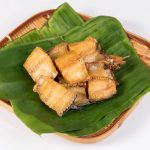
Postpartum mummies are encouraged to eat hot rice and suitable drinks such as wood root water.
Ingredient A
- 1 pieces snakehead fish (cleaned and cut)
- 2 spoons black pepper sauce
- 1 spoon fish curry powder
- 1 tbsp turmeric powder
- salt (as per taste)
- cooking oil
Ingredient B(Pounded)
- 30 g ginger
- 2 large onions
Marinade the fish with the turmeric powder and salt for about 15 minutes.
Let the pan heat up for a few minutes before adding the oil. Fry the snakehead fish until it is crispy.
In another pan, heat some oil and sauté the pounded ingredients.
Add some black pepper sauce, fish curry powder, and salt.
Mix the ingredients well and pour it over the fish.
Serve with bowl of hot rice.
Salted Fish with Black Pepper
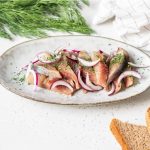
Black pepper is great for your postpartum recovery. It can also improve your immune system and digestive system. Try adding it into your confinement meal when possible.
- salted fish (cleaned and cut)
- black pepper powder
- lemon zest (as per taste)
Fry the salted fish without any oil.
Sauté some shallots with the fish. Add some black pepper over it.
Squeeze in some lemon zest.
Mix the ingredients well.
Serve with a bowl of hot rice.
Practice a healthy diet during your confinement!
Mummies must follow a healthy confinement recipes to maintain healthy diet during postpartum period. These recipes are super easy and healthy for you. So, make sure to try it and feed your whole family with these effortless dishes! Remember, the key to a quick recovery is to maintain a healthy diet and have enough rest after giving birth.
Click here for more nutritious confinement recipes.
For more insightful stories and fun recipes, stay tuned to Motherhood Story! -
![img]()
First Year Toddler: Sixteen-Month-Old Developmental Milestones
Jia Ying
January 28, 2022
4 min
As you think about your little one approaching half of his second year, then it is time for you to look into the 16-month-old developmental milestones.
By now, your 16-month-old is basically is an explorer. Since he is able to walk in a steady manner, he would now try to run and climb over here and there.
While ensuring that your house is childproof, it is equally essential to give our toddler more freedom to discover his surroundings. You should try to talk more with your toddler now as he is able to understand more about what you say.
Let's wait no more to look into what you can expect from your 16-month-old toddler.Sixteen-Month-Old Developmental Milestones
16-month-old Sleep
In between his 15th and 18th months, your toddler is more likely to drop his morning nap. It means that he is going to have only a midday or afternoon nap for around two hours.
However, do ensure that your toddler does not take the nap too late in the day so that he can fall asleep at night. If you are unsure wether what time is considered to be too late, simply remember this following tip:A toddler's bedtime should be no later than 4 hours after he wakes up from his afternoon nap.
While your little one is going to sleep for around 11.5 hours during the night time, do try to establish a good bedtime routine if you haven't. Taking around 20 to 30 minutes, you can prepare your toddler for sleep with same daily rituals such as bathing or reading bedtime stories in the exact same order.
Here are some suggestions that you can practise for your toddler's bedtime routine:
16-month-old Feeding
As you serve your toddler with three meals and two snacks a day, this is how you can estimate how much food you can serve your toddler. Most toddlers would need around 1000 calories every day or 40 calories for each 2.5cm of his height.
Suggested by professional doctors, your toddler should have three 8-ounces cups of whole milk per day to have adequate intake of calcium. Moreover, you should also feed your toddler with iron-rich food.
Here are some iron-rich foods that your toddler can enjoy: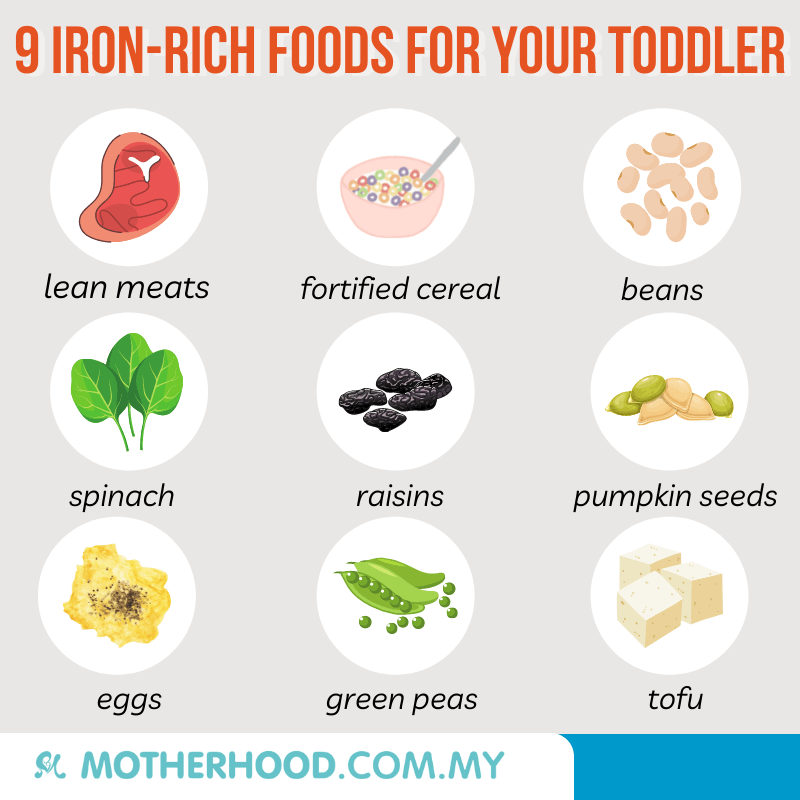
Key Milestones In Growth
How should your 16-month-old toddler grow in terms of weight and height? Here are the averages that you can expect from your sixteen-month-old baby.- Weight: Around 9.8 kg for a 16-month-old baby girl and 10.52 kg for a 16-month-old baby boy
- Height: Around 78.48 cm for a 16-month-old baby girl and 80.26 cm for a 16-month-old baby boy
On the other hand, your toddler might start to have his third bottom tooth erupting as early as in his sixteenth month. Thus, if your toddler happened to be cranky out of the sudden, it might due to the teething pain.Key Milestones in Skill Development and Senses
Key Milestones in Movement
- can walk steadily and more independently
- may start to climb up furniture and run
- can pick up a ball or other object that is in motion
- can feed and drink from a cup by himself with some spillage
- can stack two to three blocks to make a tower
- can flip over books
At this age, your toddler is going to be very curious that he would walk, run and even climb while making a mess and chaos around the house. As this is due to his impulses, he does not always understand what is or isn't acceptable. Therefore, we need to help him to understand that his misbehaviour is not appropriate.
With this, you would need to set up some boundaries and expectations and introduce the concept of consequences. Here are some tips that you may practise to discipline and teach your toddler on good behaviour: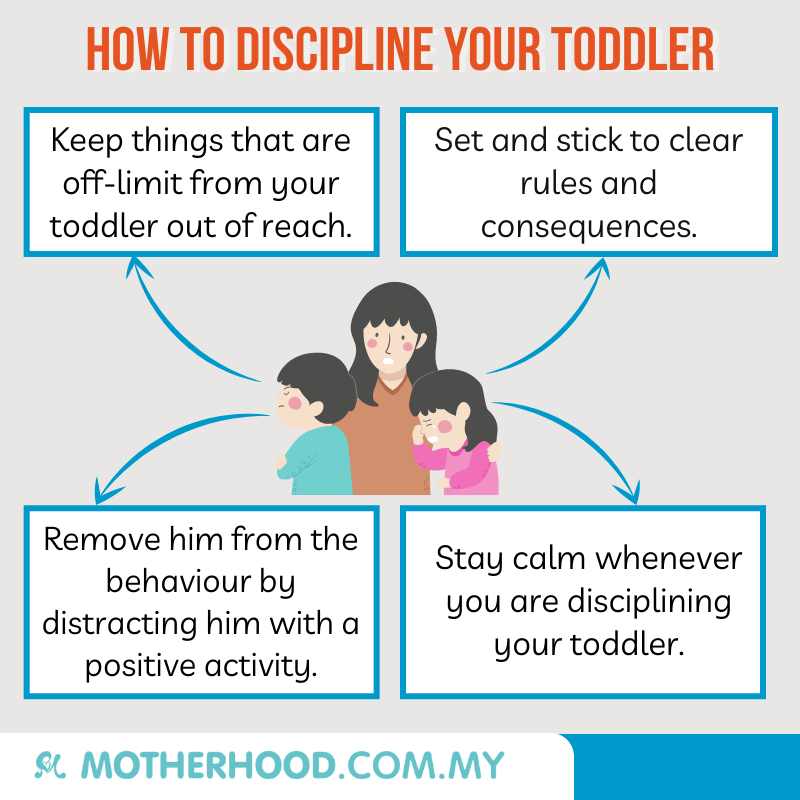
Key Milestones in Five Senses
- can say between seven to fifteen words
- can understand more commands and daily conversations
- enjoys pretend play
- uses eye contact and gestures to get what he wants
- starts to develop a sense of what's right and wrong
- being more self-centered
Have you ever seen your little one refusing to share his toys with his peers or siblings, even when he is not playing? Worry not, it is just that he does not understand that others have different feelings from his own.
What he has in mind currently is just:The world revolves around me.
With that in mind, you can gradually introduce the value of empathy to your toddler through your actions as followed: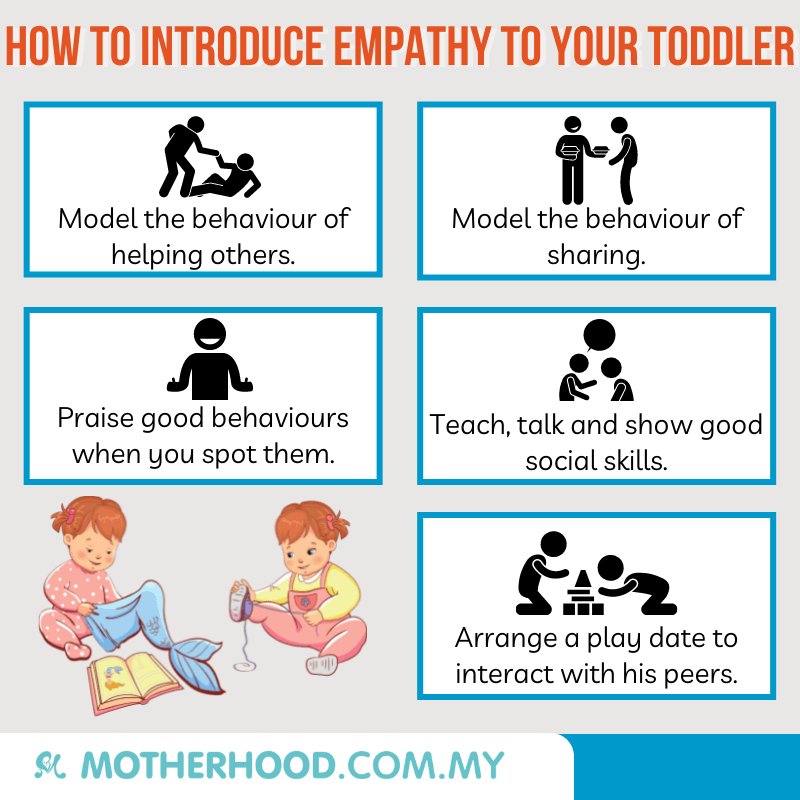
16-Month-Old Baby Activities
At this stage of toddlerhood, you are going to have so much fun playing with your toddler. It is also great if you can bring him outdoor to discover the world around them. Believe us, your toddler is going to enjoy his time at the playgrounds, parks and open areas.
Besides exploring the nature, you can equally plan activities that enhance his skills and development as follows: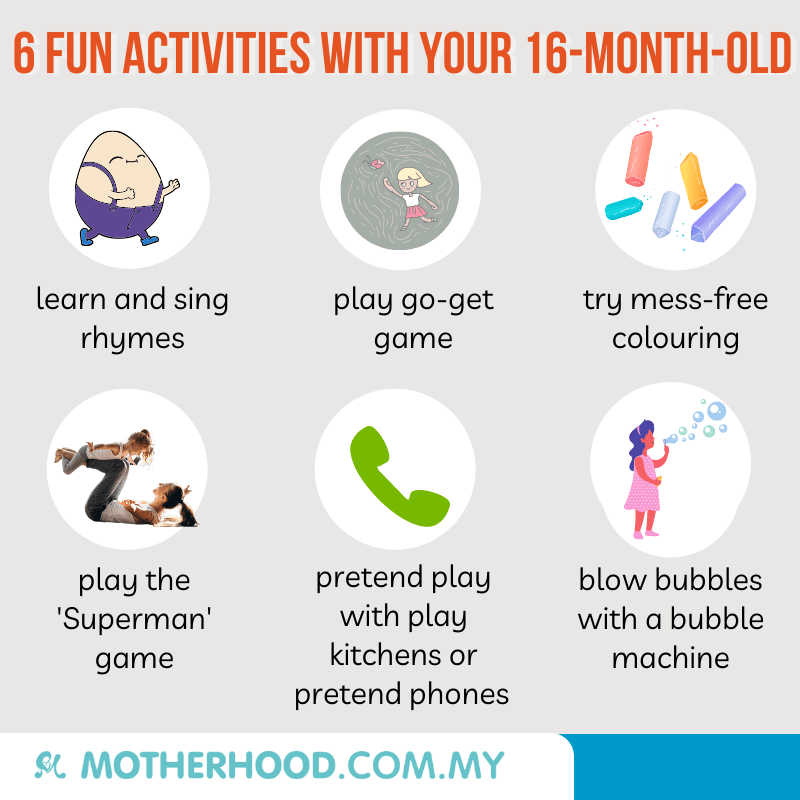
Say 'No' to Developmental Milestones Comparison
While it is easy for us to fall into the trap of comparing our little one with his peers of a similar age, always remind yourself that every child grows at their own pace.
Therefore, stop comparing and instead, support your toddler's growth and development with nutritious food, physical activities and love.
For more interesting stories and fun recipes, stay tuned to Motherhood Story!
-
![img]()
Broccoli During Pregnancy: 7 Broccoli Recipes to Try at Home
Ishita Mondal
September 05, 2023
7 min
Broccoli is a nutrient-enriched vegetable that you can eat in many different ways. While some are fond of roasted broccoli, some prefer Chinese broccoli recipes. Some of you probably are in love with the delicious cream of broccoli soup.
Simple sautéed broccoli salad is also on the favourites list for many. So, considering its versatile usage in cooking, we share some healthy broccoli recipes for pregnancy days. Before we delve into the recipes, let's know how broccoli can help you stay well with your baby in the womb.The Health Benefits of Broccoli Recipes during Pregnancy
The elegant-looking green cauliflower (its appearance made me decide on this name) is packed with healthy nutrients including vitamins, minerals, fibres, and others. Not only your own health but also your foetus' well-being is ensured with well-cooked broccoli recipes. The significant health benefits are:- Smooth Bowel Movement: Many times, pregnancy brings the issue of constipation. The fibre in broccoli makes the bowel movement smooth relieving you from the discomfort of constipation.
- Reduced Risks of Anaemia: Being a natural source of iron, broccolis reduces the risks of anaemia. Once you start having broccoli in your regular pregnancy diet, you may not need to take additional iron supplements.
- Glow in the Skin: Mothers deserve to look beautiful with healthy, glowing skin. The hormonal changes may bring a natural glow in the skin. Add more to it with delicious broccoli recipes in your meals these days.
- Increased Immunity: Broccoli is a vegetable that improves your immunity keeping you safe from the risks of diseases. Both you and your baby can grow well with boosted immunity.
We hope, now you have an idea about how beneficial broccoli is for your health these days. Without much delay further, let's move ahead with the broccoli recipes.
Garlic-smeared Sautéed Broccoli

Broccoli is a vegetable that you can eat with minimal cooking. However, it is not recommended to have raw, or half-cooked veggies during pregnancy. Therefore, we share a recipe that brings broccoli to your plate in a well-cooked, healthy, and delicious form. Let's have a sneak peek to the recipe.
- 400 gms broccoli florets ((washed, rinsed))
- 2 tbsp olive oil
- 2 tbsp butter ((unsalted))
- 3 tbsp lemon juice
- 6-7 cloves garlic ((finely chopped))
- 1 inch ginger ((minced))
- salt and black pepper ((as per taste))
Boil broccoli florets and keep them aside.
Heat oil in a pan and melt butter with olive oil in it. Sauté garlic and ginger in it for 1-2 minutes.
Once the garlic turns slightly brown, add boiled broccoli florets to it.
Cook for 5-10 minutes. Drizzle lemon juice over it. Sprinkle salt and black pepper to taste.
Stir to mix all of the ingredients. Serve hot.
Fried Chinese Broccoli with Kailan and Mushroom
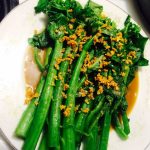
Let's deviate a little bit. Instead of regular broccoli, we can add some variation to the dishes using kailan which is Chinese broccoli. It is a great option if you want to start your day with healthy diet. As
- 400 gms kailan or Chinese broccoli ((stems, leaves, and, buds are cut into pieces))
- 2 tbsp olive oil
- 2 tbsp light soy sauce
- 1 carrot ((chopped))
- 200 gms mushrooms ((pregnancy-friendly))
- salt and black pepper ((as per taste))
- 1/2 cup green peas
- 3 cloves garlic ((minced))
- 1 inch ginger ((minced))
Boil kailan until they become tender. First, cook the thick stems and then add the rest of the parts.
Once the kailan is cooked, add carrot and green peas to the boiling water with kailan. Cook for 10 minutes.
Heat oil in a pan and add garlic and ginger to it. Stir-fry mushrooms until the liquid goes away.
Pour the kailan, carrot, and peas into the pan. Mix all of the ingredients well. Add salt and black pepper as per taste.
Add soy sauce, stir well, and cook for 5 minutes. Serve immediately.
Broccoli and Mushroom Fried Rice

- 150 gms broccoli ((cut into small florets))
- 100 gms mushrooms ((pregnancy-friendly))
- 1/2 cup green peas
- 500 gms brown rice ((cooked))
- 4 tbsp light coconut milk
- 2 tbsp light soy sauce
- 2 inch ginger ((minced))
- 3 cloves garlic ((minced))
- 3 tbsp olive oil
- salt and black pepper ((as per taste))
Sauté ginger and garlic in oil.
Then, fry broccoli, green peas, and mushroom on a medium heat.
Add rice to it and cook for 5-7 minutes. Stir occasionally so that the rice does not stick to the bottom.
Add coconut milk and light soy sauce. Cook for 10 minutes more.
Add salt and black pepper. Mix everything well and close the lid. Cook for 5 minutes. Serve hot.
Roasted Broccoli with Almond Dressing

With a chunk of almonds and sufficient drops of lemon juice, the dish is exclusively tasty and healthy. This pregnancy-friendly broccoli salad is a perfect treat for your pre-motherhood days.
- 300 gms broccoli florets ((washed and boiled))
- 2 tbsp olive oil
- 100 gms almonds ((chopped))
- 1 inch ginger ((minced))
- 2 tbsp green onions ((chopped))
- 4 tbsp lemon juice
- 1/2 tsp sesame seeds
Sauté boiled broccoli florets in oil with ginger for 5-10 minutes.
Add almonds and cook for 5 minutes. Then, add green onions and sesame seeds. Stir well.
Mix salt and black pepper as per taste.
Drizzle lemon juice and mix all of the ingredients well.
Sprinkle some more sesame seeds and serve.
Slow-cooked Broccoli and Salmon

- 200 gms broccoli florets ((boiled))
- 250 gms fresh salmon
- salt and black pepper ((as per taste))
- 1/2 cup light coconut milk
- 1 tbsp oregano herbs ((pregnancy-friendly))
- 2 tbsp coriander leaves ((chopped))
- 2 tbsp lemon juice
- 1/2 cup carrots ((grated))
- 1 tbsp ginger-garlic paste
- 2 tbsp olive oil
Boil broccoli and salmon separately. Keep them aside.
Heat oil in a pan and sauté the boiled broccoli with ginger-garlic paste.
Add the salmon and cook for 5 minutes. Add grated carrots and stir for 5-7 minutes.
Pour light coconut milk and cook for 10 minutes.
When it is boiled, add coriander leaves, salt, black pepper, and oregano herbs.
Stir well and drizzle lemon juice before serving. You can add fresh cream on it if you want.
Broccoli and Chickpea Curry

- 250 gms broccoli florets ((washed and boiled))
- 200 gms chickpeas ((soaked overnight))
- 1 tsp cumin powder
- 1 tsp coriander powder
- 1 tsp turmeric powder
- 1 tbsp ginger garlic paste
- 1 tbsp chopped coriander leaves
- 2 cup vegetable broth
- 1/2 cup light coconut milk
- salt and black pepper ((as per taste))
- 1 tbsp butter ((unsalted))
- 1 cup spinach ((chopped and blanched))
- 2 tbsp lemon juice
Boil chickpeas with a pinch of salt. Add it with garlic and ginger paste into a pan. Sauté them lightly.
Add broccoli and spinach to it and mix well. Sprinkle the spices and stir for 5-10 minutes.
Add vegetable broth and coconut milk to it and cook for 10 minutes closing the lid.
Sprinkle chopped coriander leaves and add butter to the curry. Stir and mix salt accordingly.
Once it is cooked well, sprinkle black pepper, drizzle lemon juice, and serve.
Tomato-flavoured Broccoli and Pasta

If you want to enjoy a tangy-sweet pasta platter, it is the best option to try. Pregnancy days are after all all about sudden cravings. Whenever you feel like having a tangy-sweet pasta curry, opt for this delicious recipe. We have not added extra spices to it as we keep it pregnancy-friendly. With broccoli florets and other ingredients, it becomes a healthy treat to the taste buds. Try it as your quick, easy, healthy dinner recipe.
- 350 g pasta ((elbow-shaped is preferred, boiled))
- 2 cup broccoli florets ((cut into small florets, boiled))
- 1 carrot ((chopped))
- 1 capsicum ((chopped))
- 2 tomato ((chopped))
- 1 tbsp lemon juice
- 1 green chilli ((chopped))
- 1 tsp oregano herbs
- 1 tbsp tomato sauce
- 1 tsp light soy sauce
- salt and black pepper ((as per taste))
- 2 tbsp olive oil
- 1 onion ((chopped))
- 1 tbsp ginger-garlic paste
Heat oil in a pan and sauté onions with ginger-garlic paste.
Add salt, capsicum, carrot, and tomatoes. Cook them until they become tender. Add oiled broccoli florets and cook well.
Pour boiled pasta into the pan and cook for 5-10 minutes.
Add a little water if it is too dry. Then, add tomato sauce and light soy sauce. Cook for 7-8 minutes.
Sprinkle oregano herbs and serve hot.
Stay tuned to Motherhood Story and Motherhood SuperApp for more fun recipes and interesting stories. -
![img]()
Tips for Working Mums: Keeping Your Routine On Track
Zakwan Shah
September 07, 2023
5 min
Working mums have their work cut out for them. Between their careers, their families and their domestic chores, there’s not much room for error.
Even one flaw in your plan can send the entire day into chaos. If you find that you’re rushing through your tasks and falling behind instead of breezing through them like these TV housewives, it’s time to recalibrate.
Here are 8 ways to keep your routine on track as a busy parent.8 Tips for Keeping Your Routine on Track as a Working Mum
Get a Wall Calendar
 Image credit: Shutterstock
Image credit: Shutterstock
A notebook or a smartphone is all well and good. They’re convenient, small and portable.
But before you type out your entire schedule on your little electronic friend, jot them down somewhere physical first. I suggest a wall calendar, and not for the reasons you might suspect.
Humans have this incredible talent for being forgetful. Writing your schedule down too early on your phone can be dangerous. Out of sight, out of mind right?
Seeing your activities plastered on the wall when you walk past it every day can subconsciously remind you of what you need to do on a given day.
As you cumulatively download your schedule for the week via involuntary glances, there is less chance of you forgetting you schedule.
That’s a little psychology hack for you.Phone Reminders
 Image credit: Shutterstock
Image credit: Shutterstock
Another foolproof way to keep you on track are phone reminders. Making lists may quell your anxiety, but you also need to make sure you remember them.
The wall calendar trick only works best if a task is schedule for the distant future, giving your brain time to gradually commit it to memory over a period of time.
It may not work that well for urgent or last minute tasks. The following tip is the next best thing. Once you pen in all of your weekly activities on your little hand-dandy smartphone, it all comes down to setting up alarms.
These reminders will alert you via ringtone of any impending tasks. The trick with these is to always set the time they go off at least an hour or half an hour early.
This gives you plenty of legroom to get your other affairs in order.Prepare a Timetable
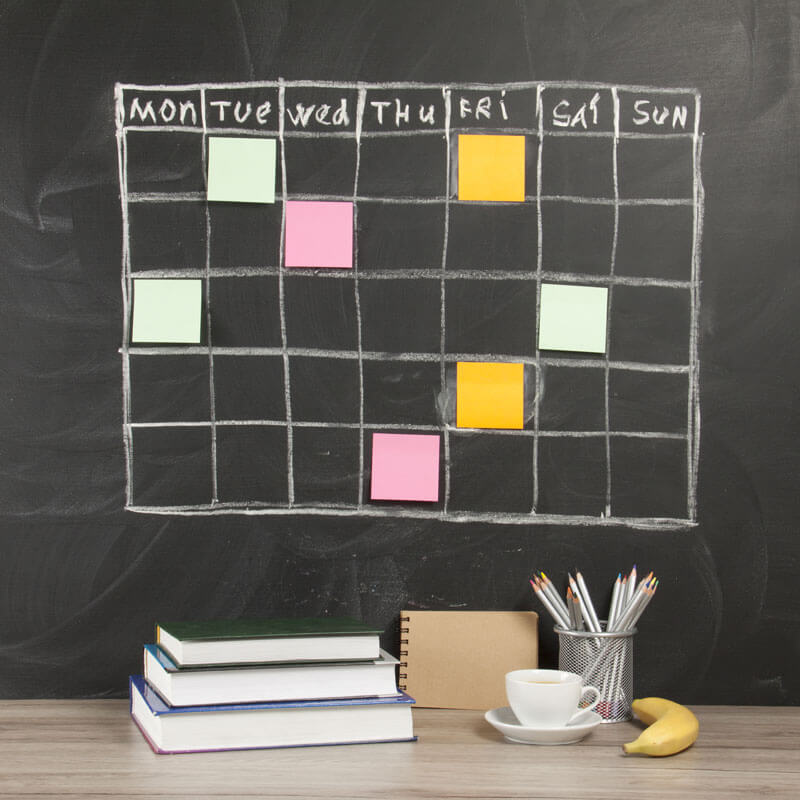 Image credit: Shutterstock
Image credit: Shutterstock
It’s best to plan out your month in advance, and map out a general timetable for all of your tasks.
There should not be much change from week to week, except maybe the weekends. There is free rein to plan out spontaneous activities if you’re not pressed for time.
So unless you lead a carefree life with not many responsibilities, it’s probably not necessary to pen everything down to the tee.
But if you spend most of your day at a nine-to-five, you may need more guidance to squeeze in a few more extra tasks.
So try to keep your routine consistent throughout the entire month. Grocery shop only on Fridays after work, exercise at 5am every day before work, dinner no later than 8pm. Things like that.Plan for Wiggle Room
 Image credit: Shutterstock
Image credit: Shutterstock
Life throws us curveballs, and that can sometimes throw a wrench in an otherwise perfectly organized day.
So plan for some wiggle room in between your activities. This ensures that any unforeseen events won’t derail your entire schedule, if something does actually go wrong.
Things like traffic jams, surprise errands, emergency stops and even, yes, unexpected bathroom breaks, can quickly add up.
So add an extra half an hour or fifteen minutes to the time it takes for you to complete an activity, just in case. This is especially important if that activity involves driving around in your car.
The road can be a mad and scary place.Pay Attention to Detail
 Image credit: Shutterstock
Image credit: Shutterstock
It is a general rule of thumb to write down the gist of what you’ll be doing on a to-do list. But people neglect the finer details.
Unless it’s something simple like taking out the trash, then you don’t need to write an essay for it.
But if it’s grocery shopping, exercising or cooking, it's best to plan out each minute of your activity.
If you’re cooking, take note of prep time. For exercising, itemize your workouts by rep, set and rest time. When it comes to grocery shopping, a list is a no-brainer.
But if you’re familiar with the store layout, align your list with the order of the aisles. For example, if 'Baked Goods' is the first section of your local grocery store, then put 'Bread' as the first time on your list.
This ensures that you don’t zigzag across the store looking for various items out of order.Prepare the Necessities
 Image credit: Shutterstock
Image credit: Shutterstock
If you know you're going to be busy the next day, plan your day in advance. Get your wallet, purse, keys, phone, etc. out in one place ready for you in the morning.
Press and hang your outfit for the day the previous night. For breakfast, make some overnight oats or some other breakfast food that can be enjoyed cold.
Ditch those early morning Starbucks coffees. You have no idea what kind of traffic those drive-throughs experience on any given day.Make your Life Easier
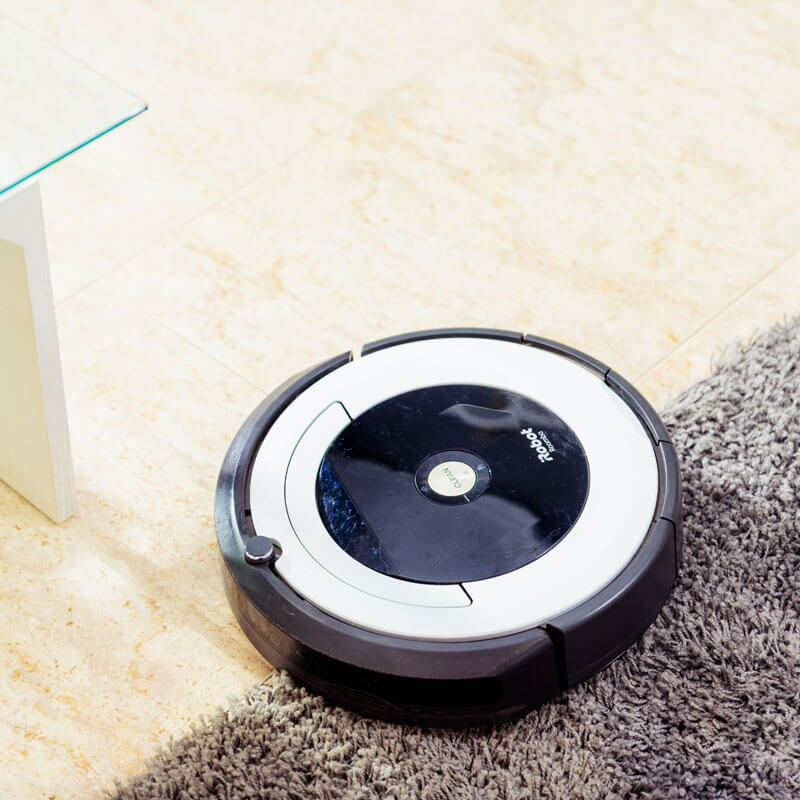 Image credit: Shutterstock
Image credit: Shutterstock
Anything that can absolutely be done with outside or non-human help, then by all means, invest in it.
Whether it’s a Roomba to cut your cleaning chores by half, a dishwasher to keep the sink clean, or a maid to deal with housekeeping. Of course, this isn’t feasible if you’re on a budget.
If you can get some helping hand from a relative or friend, time to cash in some favours.Set Aside One day
 Image credit: Shutterstock
Image credit: Shutterstock
Following a routine 24/7 isn’t ideal for your mental or physical health. For anyone, parent or otherwise.
Being organized and perfect all the time reduces setbacks, but controlling everything all the time can be pretty stressful.
So allow yourself one day, or several hours at the end of the day, for complete and absolute anarchy. Within reason, of course.
Maybe opt for some take-out instead of cooking a home-cooked meal.Practice makes perfect
Once you get into the groove of a routine, you’ll find that it becomes easier.
Unless your schedule is always subject to change, there is not much that can be done about helping you acclimate.
Be that as it may, there are still many wonderful benefits you can get from planning your life. You’ll be more organized, confident and less stressed. Especially if things go exactly as you intended.
But be sure to not take it too hard on yourself. Sometimes even busy mums need to let their hair down.
A little bit of chaos once in a while is a much-needed change from a strict and predictable life.
So don’t forget to take it easy on yourself, you’ve done enough to deserve a day off.
For more insightful stories and fun recipes, stay tuned to Motherhood Story!
Navigation
Our menu boxes are very flexible and easy to use




